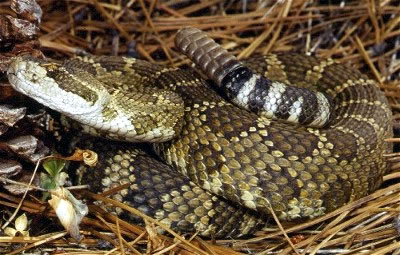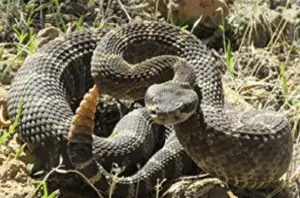
Snakes. So many snakes and honestly so many of my worst nightmares involve these slithering members of our natural world. While well over 90% of the time a snake is going to be harmless to a human in the United States, there are plenty of venomous snakes you should be aware of.
Especially if you’re visiting an area that is known to have them (especially if you’re going to be fishing, hiking, camping in their habitat).
While neither my brother or I are big snake fans, in fact it’s one of my few phobias, this is one of those articles that we feel like needs to be out there because finding a detailed and balanced article on all the venomous snakes that can be found in the United States turned out to be stupidly difficult.
Which, as described before, is stupid. So despite the fact that even many pictures, much less videos, really make me nervous, we want to provide an outstanding detailed article on all of the most venomous and potentially deadly snakes native to the United States so you can find this information in one place.
Hope you enjoy!
Table of Contents
Introduction to America’s Venomous Snakes

There are four general types of venomous snakes that are native to the United States. While there are stories of police searches for escaped cobras (in Florida, of course), which would be far more dangerous than any other venomous snake in the area, the logical focus is on native snakes here. Ones that naturally are born, bred, and whose natural habitat is in the United States.
There are over 20 species/sub-species total among all these groups, with a few others that are recognized informally, but haven’t officially been labeled as their own sub-species yet. However, these can be put into four basic groups:
- Rattlesnakes
- Copperheads
- Coral Snakes
- Cottonmouths (Water Moccasins)
These are the snakes we’re going to focus on here, and we’re aiming to hopefully give the best blog post on US-based venomous snakes that you will find anywhere online.
A Note on Poisonous Versus Venomous
Some people would call this a technicality, some semantics, but there’s no question that calling rattlesnakes, coral snakes, copperheads, and cottonmouths poisonous just isn’t correct. Venomous refers to a snake that can inflict venom and thus “poison” a person thus making them sick or even killing them. Poisonous would mean you eat the snake you die.
Rattlesnake actually does taste a lot like chicken (though with a lot of small bones), but you’re not going to die from eating it. These snakes aren’t poisonous – they’re venomous. Those are two different things and you’ll want to make sure you understand the major difference because otherwise you’re painting yourself as a real amateur or someone who didn’t do their homework on one of the most basic facts about these reptiles.
Snakes that can sicken or kill you are venomous. None of them are poisonous (see once again how rattlesnake tastes like chicken).
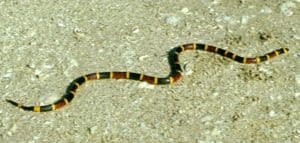
American Coral Snakes
These are some of the most interesting of all the venomous snakes that can be found in the United States. Not only are they extremely unique compared to the other species found throughout the nation, but there is probably no venomous snake in the U.S. that is more misunderstood.
This doesn’t necessarily come from old wives’ tales or made up stories that had a way of just sticking around – often times they come from half truths or pieces of fact that aren’t put into proper context. One common example of this is the oft-told story of coral snakes being the deadliest in the U.S. because they are a relative of the deadly cobra.
Cousin to the Cobra
That interesting fact about being related to the Asian cobras is true. The coral snakes you find in North America are related to cobras, but unlike their infamous cousins, coral snakes tend to be small (most are 14-20 inches though they can get up to 3 feet long in the right conditions), thin, and are actually very shy.
Also setting them apart from cobras, and every other venomous snake in the United States, is the fact that do not have fangs, meaning in general they pose very little to no threat to people in most cases. Their venom is an extremely dangerous neuro-toxin but unlike the fangs of pit vipers, coral snakes do not have an easy or reliable delivery system.
The lack of fangs with their generally shyness means it is really, really hard to get bitten by a coral snake. In fact, to get bitten by a coral snake, much less envenomed, usually takes a level of bad judgement and/or persistent stupidity.
That doesn’t mean you should handle them or not be cautious – their venom is the most dangerous if it gets in your system, so give them the respect they deserve. In fact any coral snake bite needs to be considered an immediate medical emergency.
Generally speaking nearly 100% of the time if you leave a coral snake alone they’ll be happy to go away and hide.

Identifying a Coral Snake
Identifying a coral snake isn’t difficult at all when comparing them to other venomous snakes. They are the extremely colorful ones with bright red sections and yellow stripes. The one snake that looks a lot like them is the king snake, which can also often be found in the same environment.
While they are the same three colors: black, red, and yellow, and have similar patterns, there is an old little rhyme that lets you tell the two apart quickly:
Red touch yellow, kill a fellow
Red touch black, venom lack.
On coral snakes the red sections are always surrounded by yellow strips while on king snakes the red touches the black and not the yellow. If you remember that rhyme you will have the ability to quickly, accurately, and easily tell about the non-venomous king snake from the venomous coral snake.
Three U.S. Species of Coral Snakes
While the similarities are going to far outnumber the differences between these three species/sub-species (sorry I’m not a biologist so bear with me if I misuse these terms slightly) there are three unique groups or families among those that are natively found in parts of the United States.
Coming from the Genus Micruroides, and viewed as in the family of New World coral snakes, there are three sub-species (there’s a bit of question over whether the Texas Coral Snake count as its own or not but we’re just going to say yes as a nod to those differences and run with it.
Those three species are:
- Arizona coral snake (very bottom of Arizona – actually more in Mexico)
- Eastern coral snake (North Carolina to Louisiana)
- Texas coral snake (east and south Texas & Louisiana)
Little Reason to Fear
Between their shy nature, the fact they live in mostly isolated natural areas, and antivenin supplies in areas where they do live, there is little reason to fear coral snakes as long as you don’t do anything stupid or reckless. In fact, the numbers released by the ANIH (American National Institutes of Health) estimates only 15–25 coral snake bites per year in the U.S.
Since a solid antivenin was developed in 1967, there has been only a single recorded case of a person dying due to a coral snake bite, and that was an individual in 2006 who found one of these snakes, tried to kill it, got bit, and then refused treatment. It was the first coral snake bite related death in nearly 40 years.
That being said if you are bit by a coral snake or even think you might have been, make sure to seek medical attention as quickly as possible.
Is There an Antivenin Shortage?
 The short answer here is a qualified yes, which is a bit frightening. Basically the entire supply current available in the United States as of this first writing (July 2017) would be considered expired by old standards, but has been given a sort of pass to be in circulation since it should still work, and there’s a shortage if it’s removed.
The short answer here is a qualified yes, which is a bit frightening. Basically the entire supply current available in the United States as of this first writing (July 2017) would be considered expired by old standards, but has been given a sort of pass to be in circulation since it should still work, and there’s a shortage if it’s removed.
One company used to make this alone, but since there were so few cases, and making it was so expensive, the program was cut. There are efforts to make a better safety net so while there is definitely a coral snake antivenin supply issue, there is enough being maintained out there for treatments even if it is limping along.
This is a good thing, seeing as how the neurotoxic venom of the coral snakes is incredibly dangerous if it gets into the blood. Not only are large doses of the proper anti-venom required but many times the patient will need artificial or supported respiration since the venom of a coral snake attacks and paralyzes the breathing muscles.
This usually takes several hours, but it’s important to pay attention since the initial bite, unlike those of a rattlesnake or other viper, generally won’t hurt that much. There hasn’t been a recorded death in the United States by coral snake since 1967 when the anti-venom was first developed, so while it can technically be deadly (and among the deadliest based on pure strength of venom) – the coral snake gives us little to fear compared to many of the others on the list.
If you want an outstanding article on the various coral snakes in the United States be sure to check out this article from reptilesmagazine.com.
More coral snake references worth checking out:

All About Copperheads
The one native American pit viper that tends to be forgotten about, copperheads also tend to be the least harmful to healthy adult humans when compared to cottonmouths or rattlesnakes, however their bite still can pack quite a wallop and they need to be given the same respect as a large rattler or aggressive Cottonmouth.
These snakes generally grow two to three feet in length if they make it fully healthy to adulthood and are pit vipers like cottonmouths and rattlesnakes. They are also among the most commonly seen of all the venomous snakes, in part because they don’t hide as thoroughly because their natural camo is so good at helping them blend in.
The North American copperhead (Agkistrodon contortrix) can be found in a wide variety of environments from southern New England down the coast throughout the entire south all the way to western Texas, as well as several Midwest States like Illinois, Missouri, and Kansas.
There are five recognized sub-species of copperhead, with the mildest of changes occurring between them based on geographic range. In other words a copperhead population in Massachusetts is slightly different than one in west Texas, but they are pretty much the same snake for all intensive non-biologist purposes.
For those who like the really in detail information, here are the five recognized sub-species of American copperhead snakes (in alphabetical order because there are certain things I am very strangely OCD about) and their scientific names:
- Broad-band copperhead (Agkistrodon contortrix laticinctus)
- Northern copperhead (Agkistrodon contortrix mokasen)
- Osage copperhead (Agkistrodon contortrix phaeogaster)
- Southern copperhead (Agkistrodon contortrix contortrix)
- Trans-Pecos copperhead (Agkistrodon contortrix pictigaster)
The most bites, very few deaths
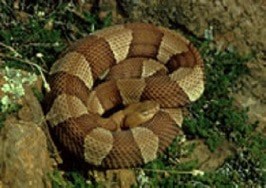
Because rattlesnakes tend to be the deadliest snakes in the United States by quite a large margin, and because Cottonmouths have a reputation for being ultra aggressive, many people are surprised to learn that the most venomous snake bites a year come from copperheads.
On average that are around 7,000 to 8,000 venomous snake bites a year in the U.S. with only 5-6 deaths. Copperheads by far and away account for the most cases of venomous snake bites, but their venom is also the least toxic. In addition to this, many copperhead bites result in only a very small amount of venom being pumped forward since the snake uses less fighting off predators as opposed to putting down prey.
Aside from the low number of bite related deaths from copperheads, there are even stories of adults getting bit and being fine (albeit in pain) without getting fast medical attention, or some at all in some cases.
NOTE: Don’t be stupid and do this. Even if you’re 99% convinced it was a dry bite, go get it checked out immediately. Copperhead venom won’t be fatal if you get it treated. Why be stupid and take the chance?
In fact the last four known deaths from a copperhead were:
- Timothy Levins, age 52, in 2014 was bit 2-3 times while picking up the snake and died many hours later after not seeking medical attention
- Terry Brown, age 50, in 2012 technically death by heart attack that had been giving chest pain warning signs for days while camping, but was bit by a copperhead and that contributed to his death nearly 24 hours after the untreated bite
- Wade Westbrook, age 26, in 2011 after handling a copperhead in the wild – he had an allergic reaction that lead to anaphylactic shock
- Trent Leprette, age 31, in 2004 multiple bites after swimming in a local creek
(Source: Wikipedia list of fatal snake bites)
Identifying a Copperhead
Masters of camouflage, while they might stick out when on a slab of gray sidewalk or black pavement, their unique coloring and design makes them practically invisible when in the forest, especially during early spring or late fall when there are leaves, twigs, and foliage on the ground.
If you don’t believe me, check out Google search results for “spot the copperhead.” Instantly you’ll see dozens of pictures and thousands of results that show just how incredible difficult it is to see
Generally speaking copperhead venom is only about 1/2 the strength or potency of rattlesnake venom. That doesn’t mean they’re not potentially dangerous, especially if an allergic reaction to the bite takes place, but it does go to show why despite there being thousands of copperhead bites a year, there are so few deaths from a copperhead bite, often less than one a year.
Understand Their Common Patterns
Understanding a few common traits of the copperhead snake can help you avoid situations where you are more likely to surprise them, or at least help teach you when to be alert because you’ll be in an area at a time where you are more likely to run into one of these copperheads.
The first thing to understand is that these snakes tend to be a bit more social than others, and because of their incredible ability to blend in (seriously, some of those photos of “spot the copperhead” are next to impossible – and maybe outright so if you’re color blind) they tend to be out more often than many other types of venomous snakes, making it more likely you’ll run into them.
Be especially cautious if:
- You’re going through wooded areas, especially wooded areas that meet other ecosystems (rocks, water, etc.)
- You’re going through woods during the day in spring and fall
- You’re night hiking or night camping in the summer
- Humid days or nights right after a rain – that’s prime copperhead weather in the woods
- You hear an odd sound like a toned down rattle and smell strong powerful musty scent – this means you may be extremely close to a copperhead without even realizing it when one gives a rare warning
Quick to Strike
It is probably a good thing that copperhead venom isn’t very potent because not only do they account for the most bites from venomous snakes almost every single year in the United States, but unlike the other snakes on this list they rarely give a warning and are extremely quick to strike (sometimes repeatedly) if they feel threatened.
Because of that, spotting a copperhead before you get too close is very important, and it’s important to make sure that any you spot you give plenty of space. Snake proof boots or gaiters aren’t a bad idea here since that can protect your lower legs from an unexpected bite from a well-hidden copperhead, but nothing is more important than simply being aware.
Always Seek Proper Treatment
While copperhead bites are very much less dangerous compared to other venomous snakes that are out there, most of the deaths or extremely serious complications that take place almost always come when a great deal of time passes between the actual bite and receiving of appropriate medical treatment that includes anti-venom.
No matter how little venom is passed along in the bite, no matter how confident you are, every single bite from a copperhead needs to be treated with the same level of care you would give to a bite from another pit viper.
While field first aid is always a good idea once you’ve moved away from the angry or scared snake, you need to get to a doctor and a medical center for proper treatment. Since snake bites from these snakes are more common than many others, it’s important to go into any wooded areas prepared and understand what you’re looking for to avoid any possible issues.
More copperhead references worth checking out:
- Live Science article on copperheads
- Great copperhead run-down (warning: some graphic pictures of damaged limbs as a result of a copperhead snake’s bite)
- Great USA Today article on copperheads
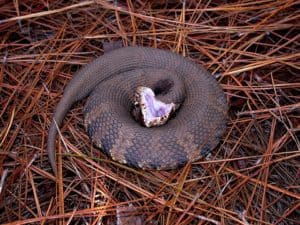
Cottonmouth aka Water Moccasin
These snakes definitely have a reputation, and that reputation is as the nastiest and most aggressive of all the venomous snakes out there. The old wives’ tale or empirical story of of these snakes often includes the “Be careful, water moccasins will actually come after you – they’re aggressive.”
That’s not to say this reputation isn’t entirely undeserved. They are a snake that is more than willing to stand its ground and strike as opposed to try to get away when it feels threatened, and since these pit vipers tend to grow to be a very thick 2-4 feet long on average (with some getting even bigger), they are intimidating reptiles who can definitely do some damage.
Featuring three sub-species, water moccasins are found throughout the south and southeast in particular. They are most commonly found in ponds, lakes, and very slow moving creeks and rivers. They’re considered the only semi-aquatic snake in the world, which really shows when you see them swimming as their heads will be above water looking up while other aquatic snakes will swim completely under the water.
These snakes go by many names, and are the only venomous water snake native to the United States.
Identifying a Water Moccasin
The coloration of a cottonmouth can actually very quite a bit depending on the area, the age of the snake, or even just between individual snakes themselves. While the common coloration they’re known for is the full black body with the very light colored pink and white interior mouth, there are many that are slightly different in color.
They can be brown and a deep yellow with black stripes, mostly dark brown, or nearly entirely black.
Finding water moccasins with rotating bands of brown and black scales is also very common they are often found in slow moving water or in the immediate surrounding area – meaning when you’re in their habitat (mostly southern and lower Midwestern states from southern Virginia to southern Missouri and sweeping into southeast Texas, you need to be careful around ponds, creeks, and small lakes especially if you’re going through tall grass and shrubbery.
There are many large black snakes in these parts of the country that can be mistaken for a cottonmouth but the real thing is usually quite distinctive by comparison.
Why the Reputation for Aggression?
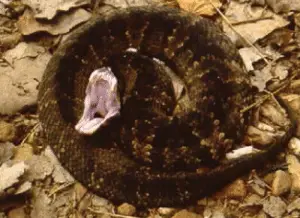
There are probably a couple factors that go into why this snake is seen as being so aggressive despite the fact that in many ways they are less likely to strike than a copperhead or some species of rattlesnakes. So how has this reputation as being the most aggressive of the American vipers stuck with them?
The first one is the fact that cottonmouths are the least likely to just run away. They defend themselves when feeling threatened by making large displays, hissing, beating their tale, or making displays to make themselves appear larger than they are.
This can definitely give the impression of being ultra aggressive when they are actually attempting to basically warn down a confrontation.
A second reason is the fact that they have the actual ability to attack while in water or underwater. Since they spend so much time there, it makes sense that people swimming in a creek or lake might startle some nearby water moccasins or be intruding in their space without knowing it.
These attacks would definitely be considered aggressive by most people, but would be the equivalent of stepping right by or moving right beside a rattlesnake – it’s intruding on their ecosystems.
Add in the fact that these snakes are often found in areas where hunters, anglers, and even summer outdoor enthusiasts like to go, and that means there are going to be times when a lot of people are going to show up in an area where this snake doesn’t want to see them – and that’s going to lead to bites and issues that may appear aggressive or overly aggressive when in reality it’s the worlds of two species slamming into each other at a very inopportune time.
Finally, let’s face it, any venomous snake strike is going to feel plenty aggressive when it happens so it’s not like any additional bites are ever going to reverse this established storyline trend.
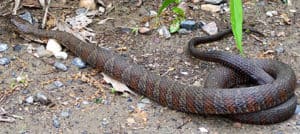
Not as many as people think
Because they can appear with various combinations of color, and because there are so many snakes out there that are primarily black or brown in color, many people assume they’re seeing a cottonmouth or several of them when in fact they are looking at large rat snakes, water snakes, or other similar looking non-venomous snakes.
This can really add to the issue of people being afraid in areas where cottonmouths are known to be because it can appear the populations are enormous when in fact they’re actually reasonably in line with the ecosystem in most areas.
That being said, always err on the side of caution when you see a snake that could be a cottonmouth. Don’t go just grabbing or handling black snakes in water moccasin country – give them a wide birth.
Especially if the heads are above water while they’re swimming and they have triangular heads. Both are clear signs that you are dealing with a venomous cottonmouth.
Deaths are relatively rare
Despite the reputation for being extremely dangerous, there are relatively few deaths from cottonmouth bites in the United States. As with many of the deaths that do occur from snake bites in the U.S. bad decisions and refusal to get prompt medical treatment often have a lot to do with it.
There was a death from water moccasin bite in June of 2017, from a male who was very intoxicated and playing with and agitating snakes. Facebook posts indicate he had been bit while he was drinking and he didn’t go for medical attention, and he died a full two days later as a result despite multiple attempts from others to get him to go to a hospital.
Before that the last one was 2015 in Missouri when an individual was bit twice while wading in a stream, refused treatment, and died late the next day. Officials in Missouri believed that might have been the only confirmed death by water moccasin bite in the state’s entire history.
While there are probably a few others, this just goes to show how few deaths come from these venomous snake bites.
Seek proper medical care and chances are overwhelming that you will manage to make a full recovery (though that doesn’t mean it won’t be frustrating or painful along the way).
More Cottonmouth pages worth checking out:
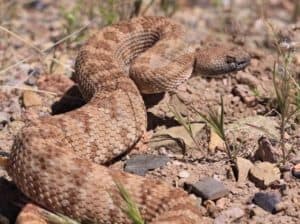
Rattlesnakes (In General)
Now here’s the really big family of venomous snakes, and the ones that my brother and I also have the most personal experience (and childhood trauma) with.
They are by far and away the most famous of the venomous snakes that can be found in the United States, have the largest range of living habitats, and also are the most diverse when looking at species and sub-species.
While the various sub-species of copperheads and water moccasins are going to more or less look the same, there are huge differences between pygmy rattlesnakes, diamondback rattlesnakes, or one of the many regional sub-species of rattlers that are out there.
These pit vipers are versatile, can adapt to an incredible number of environments, and are the best known of all the naturally venomous U.S. snakes for good reason. This group of snakes includes the most dangerous snakes to humans, those who bite the most, as well as sub groups who virtually never bite a person.
What’s the comprehensive list?
Finding a fully comprehensive list of all the species and sub-species of rattlers in the United States is extremely difficult, but the range is generally considered 16-20 different species are found in the U.S. with many more sub-species and many others found throughout North and South America.
We’ve done our best to put together a comprehensive guide of all the rattlesnakes found in the United States, but definitely hit us up in the comments and let us know if we missed any!
Without further ado, here is a whole lot more on the venomous rattlesnakes found throughout (or in small pockets of) the United States.
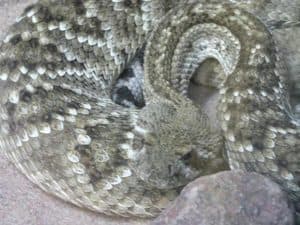 Diamondback Rattlesnakes
Diamondback Rattlesnakes
If there’s a species of rattlesnake that is the royalty of these pit vipers, it’s definitely the diamondback. Not only are the Eastern & Western rattlesnakes among the largest, they’re also among the most dangerous, the most venomous, and most aggressive.
Add in the fact they are found throughout most of the United States and distinctive back pattern and it should come as no surprise that these rattlesnakes would be the equivalent of the head honchos when it comes to talking about venomous snakes found in the U.S.
While very similar to one another, the Eastern Diamondback and Western Diamondback rattlesnakes are two distinct species, and are overwhelmingly responsible for the majority of snake bite deaths in the United States every single year.
While we can’t emphasize enough that snake bite deaths are extremely rare and you’ll probably be fine 99% of the time if you just leave them alone, but among snake bites while diamondbacks are less than 10% of the total venomous snake bites in the United States, they’re also responsible for 95% of deaths.
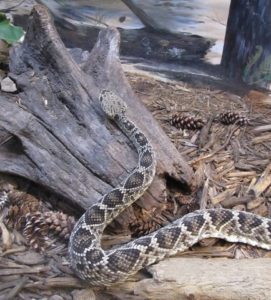
Eastern Diamondback
The Eastern Diamondback Rattlesnake (Crotalus adamanteus) is the largest venomous snake in the entire United States with adults reaching an average length of 5 feet but larger adults reaching a full 7 feet (nearly 8 feet) in length, and that’s a thick seven feet. These are truly huge snakes whose fangs can be up to a full inch in length.
These snakes are found from the lowest southeast setion of coastal North Carolina down through South Carolina, major swaths of Georgia, Alabama, & Mississippi, and all of Florida. They can also be found in a small sliver of Louisiana.
In addition to this, the Eastern Diamondback knows it is feared and “king of the roost” with a very sullen and bold overall attitude that can quickly turn aggressive. This lack of fear means there are more contacts with people, and there have been several reports of the snake becoming aggressive to people in an area, even pushing the confrontation.
While this is relatively rare behavior, they are one of the few venomous snakes who are willing to push the envelope again – they know they’re deadly. Found throughout pine forests, swap forests, and mixed woodlands, these large pit vipers have a fearsome reputation, and for good reason.
Common Eastern Diamondback Rattlesnake Nicknames: Common Rattlesnake, Diamond Rattlesnake, Diamond Rattler, Diamond Snake, Florida Diamond Snake, South Woodland Rattler, Water Rattler, & Lozenge-Spotted Rattlesnake.
Deadly Venom
The venom of an Eastern Diamondback is a very powerful hemotoxin that is dangerous not only because of its direct effects (and potent ability to be fatal in humans) but this type of venom also attacks the red blood cells while causing some serious tissue damage at every level.
Bites tend to be incredibly painful from the get-go, and localized swelling happens quickly as does the initial discoloration. These symptoms can spread throughout the body as the venom spreads, especially if not treated immediately.
Few people die from Eastern diamondback bites, in large part because of the wide availability of anti-venom that is available in hospitals and clinics around the areas where these snakes are known to be.
However, bites from diamondback rattlers are among the most common venomous snake bites that doctors in the United States see each and every year, and they do account for a large number of the bites that are fatal.
Normally this is due to a person not getting treatment for the snake bite, or waiting too long and having an allergic reaction to the toxic venom. This is why being treated with the proper antivenin quickly is so important: so it can start countering the direct effects immediately but also so it can help slow down or stop allergic and natural reactions that are indirectly caused by the venom.
If you want to see how unpleasant these look, just Google “Pictures of rattlesnake bites.”
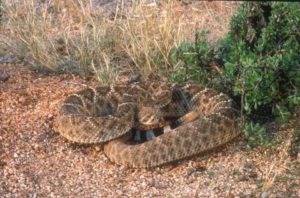
Western Diamondback
The Western Diamondback Rattlesnake, as you would expect, is closely related to its cousin, the Eastern Diamondback. While they don’t get quite as large, this is still a species of rattler that gets extremely large and can deliver a very potent bite that should not be taken lightly.
Basically picking up from where the Eastern Diamondback rattlers leave off, the Western version of these rattlers is found throughout most of Arkansas and out west through much of Oklahoma, Texas, New Mexico, Arizona, and a small section of southeast California. These distinctively marked snakes are among the most aggressive of venomous snakes and their venom packs quite a wallop to unsuspecting hunters, hikers, ranchers, or campers.
Like its cousin, this snake is used to being top threat in its ecosystem, and they have a reputation for being very aggressive and one of the rare venomous snakes that are more than willing to take a confrontational attitude with a human as opposed to immediately retreating. That being said, most of the time, like most snakes, if you back off, give them space, and time, they will eventually choose to go away.
After all, you’re way too big to be prey.
Common Western Diamondback Rattlesnake Nicknames: Coon tail rattlesnake (based on some having white and black rings that remind many of a raccoon’s tails), Buzz Tails, Desert Diamond Rattlesnakes, Desert Diamondback Rattlesnakes, Texas Rattlers, Adobe Snake, Adobe Rattler.
Identifying the Western Diamondback Rattler
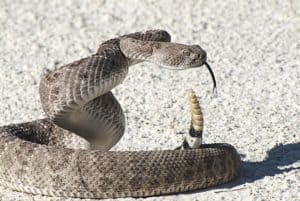
These large venomous snakes have the same very distinctive diamond pattern they’re named after, although with the Western rattlers these patterns are lighter than the ones the Eastern Diamondback has, making them a bit less distinct when compared to one another. Coloration also varies more with these guys, and can be as different as light tan to dark red depending on their specific area of habitat.
However all of these snakes have a very distinct aesthetic feature: they have multiple black and white bans that alternate right before the tail turns into a rattle. Normally this is 4, 5, or 6.
Finally, it’s worth noting that many of the best pictures of a rattlesnake poised to strike actually come from these rattlers. The Western Diamondback in particular is known for raising it’s body into a classic S-shaped coil, making it taller, distinctive, and allowing large predators to see the whirling tail as the snake is cocked back and ready to strike.
At this point, it’s also worth noting that in recent years the western diamondback is the single species responsible for more rattlesnake bites on humans than any other rattlesnake in the U.S.
Be careful around these buggers!
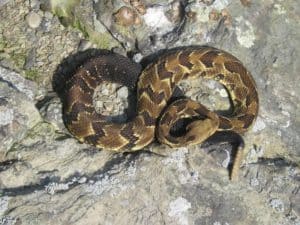
Timber Rattlesnakes (& Canebreak Rattlesnakes)
(*Timber rattlesnakes and canebreak rattlesnakes used to be considered separate sub-species that were particularly closely related, however they have since been combined and are considered one sub-species though there are those who don’t 100% agree with this change within the field of biology/herpatology)
Timber rattlesnakes are often the most dangerous venomous snake in the United States after the Eastern and Western Diamondbacks. While they account for very few snake bites overall, they do account for a very large percentage of the non-diamondback fatalities that come specifically from a rattlesnake bite in the States.
There are a couple reasons for this. One is that the timber rattler can grow to pretty impressive size in both length and width, meaning this is a large rattlesnake that can produce a large amount of venom with each strike.
That being said, most bites come from messing with a snake or a surprise run-in. While diamondbacks can be quite aggressive, timber rattlers are not.
Timber rattlesnake appearance
One form is gray with black patterns; another form is tan with brown patches tinged with yellow. They sometimes have a yellow or brown or reddish stripe down the back. Their patterns vary but often fit into the local ground flora, allowing them to blend in. Timber rattlesnakes especially tend to need good camo because they are ambush predators who don’t really move with the speed or aggressiveness of many others.
These are a thick bodied snake and although the average adult is often around three feet in length they can grow up to five feet long.
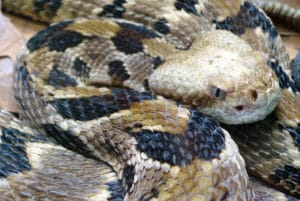
Widespread yet rare…
Two seemingly contradictory descriptions of timber rattlers, it’s true to say that timber rattlesnakes are both very widespread habitat wise and yet also generally quite rare. These rattlesnakes can be found in every state west of the Mississippi River other than Michigan, as well as every state bordering the Mississippi on the western side, as well as parts of Texas, Oklahoma, Kansas, and Nebraska.
This is a huge living range (the largest among a single species of rattlesnake in the United States) however in many of these Eastern or Midwest states they are contained within a very small area and maybe even a very small section of the state.
This means that despite being seen in a huge number of states, in many of those states timber rattlers are only found in 10% of the state or less and are protected populations in those areas because there are so few where they are found.
In other words they somehow are widespread in area yet also very uncommon and rare in most places.
Just leave ’em be…
Many times these snakes aren’t aggressive at all but fat, lazy, and just want to be left alone. Case in point was the August 2017 viral rattlesnake Brown County State Park video in the state of Indiana (you can check it out HERE). That’s a really, really big timber rattlesnake. It is moving really slow across the trail, and it doesn’t even stop to look at the people close by, it just wants to get from one part of the woods to the other, crossing the open trail on the way.
Or the consequences could be dire
While timber rattlesnakes tend to be among the most passive of rattlesnakes, and there are even instances of them not bothering to rattle until they’ve been annoyed or aggravated multiple times, their venom still pops quite a wallop. Among non-diamondback rattlesnake bites that ended up being fatal, timber rattlers take up quite a bit of that list.
While they don’t like to be aggressive, they are large pit vipers that can pack quite a bit of venom in a bite and the fact they’re often found in isolated areas only makes them all the more dangerous if they are accidentally stepped on or aggravated to the point of striking.
If you are bit by a timber rattler, seek medical attention. Their bite is nothing to play with.
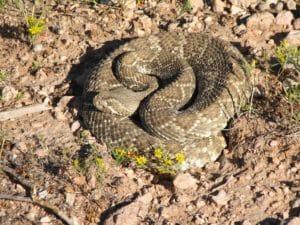
Mojave Rattlesnakes
Mojave rattlesnakes are an extremely interesting species of rattlesnakes because the type of venom and the danger from a Mojave rattlesnake bite is going to vary immensely depending on the location as well as the type of sub-species.
Most rattlesnakes have one very specific type of venom but Mojaves are not like that. A bite from a Mojave rattler can be extremely dangerous and arguably even the most dangerous of all the venomous snakes in the United States.
Why is this?
A truly unique venomous snakebite
Because even if the snake is correctly identified as a Mojave rattlesnake as opposed to a the often similar looking (and much more common) Western Diamondback rattlesnake, the venom of a Mojave rattlesnake bite can be really different in ways that make it hard to properly treat.
Their bite can be hemotoxic OR neurotoxic OR both. Every other venomous snake species found in the United States is just one or the other. Mojaves have snakes in both fields. Even stranger and potentially more frightening is the fact there have been some Mojave rattlesnake populations have bites that produce both types of venom in a single bite – making them incredibly life threatening in nature.
This is true even if you can get to medical help soon or don’t have any worrisome allergic reactions to either type of venom.
That’s part of the reason despite very few bites, and very few deaths, the bite of the Mojave is considered one of the most potentially dangerous rattlesnake bites out there.
Common symptoms after envenomation includes:
- Severe shooting pain
- Heavy swelling
- Tissue discoloration around the bite
- Difficulty breathing
- Nausea and sickness
- In extreme cases left untreated, death
Sometimes uniquely green in color
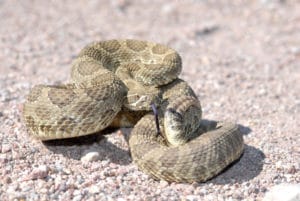 Some Mojave rattlesnakes have a uniquely green color to them, which can definitely make them stick out a touch more compared to their cousins. These snakes tend to rarely be in areas that heavily populated, but the greenish ones look a lot less like the Western Diamondback rattlesnake that some Mojaves are mistaken for.
Some Mojave rattlesnakes have a uniquely green color to them, which can definitely make them stick out a touch more compared to their cousins. These snakes tend to rarely be in areas that heavily populated, but the greenish ones look a lot less like the Western Diamondback rattlesnake that some Mojaves are mistaken for.
The most dangerous populations are generally found in central and southern Arizona in isolated areas, as that place is where you are most likely to find the rattlesnakes that have a mix of both types of snake venom.
While these snakes want to be left alone, they can also be very aggressive when cornered, and have been known to encroach on man made settlements and buildings during mating season – showing less fear than some of their more bashful cousins.
Keep in mind, their aggression almost always comes from being cornered or bothered. In other words, they become nasty when you force them to defend themselves. If left alone, they (like the far majority of venomous snakes) are happy to leave and be left alone.
Don’t take any chances
The venom from a Mojave rattlesnake is particularly dangerous when you do have a bite, so don’t take a chance. If you’re bit, seek medical attention immediately. Bites from Mojave rattlesnakes are rare but they can be extremely deadly and the earlier you get proper medical treatment, the better.
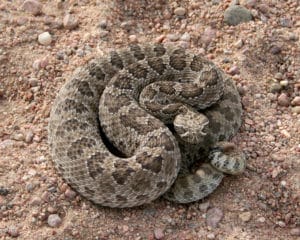 Prairie Rattlesnakes
Prairie Rattlesnakes
Although at one time possibly much more widespread, modern day the prairie rattlesnakes have a much smaller living area today, although anyone who farms large swaths of the Dakotas will tell you how important it is to keep an eye out for them.
Also known by the common names of Great Plains rattlesnakes and sometimes locally as Western rattlesnakes, although this is an incorrect identification as there is an actual species called the Western rattlesnake with multiple recognizable sub-species in the United States.
Note: this seems to be the case with thorough research but I am not a herpetologist so if I mis-understand or have it messed up, please e-mail me to contact me and help correct me ((with credentials and/or references)) – I appreciate it, we do the best we can to be on target with proper info, but some things are a bit beyond our current education and specialties.
Update: Good to know my confusion wasn’t stupidity, there was a reason to be confused, as a simple Wikipedia page shows HERE.
Prairie rattlesnakes are quite remarkable, in large part because they have thrived whereas many other rattlesnake species have not. They have the longest range of any rattler found in the United States and stretch from southwest Canada all the way through the central and the Rocky Mountain United States and even into Mexico. That is quite an impressive range.
Appearance
Prairie rattlesnakes can vary from a mostly light brown color to a heavy green, and both species tend to have yellow bellies that help create a localized camouflage that helps them easily in tall grass, woods, or the common forest floor foliage depending on the area. They also often display very dark oval blotches along the center of the back, which will eventually turn into very distinctive crossbands on the body until they become rings by the time they reach the tail.
These snakes can grow to an impressive size. Although not quite the size of the diamondback rattlers or timber rattler, they commonly get up to 40 inches (and a record sized one grew to an incredible 57 inches in length). In a couple states, such as South Dakota, these are the only native venomous snakes that are actually native to the state.
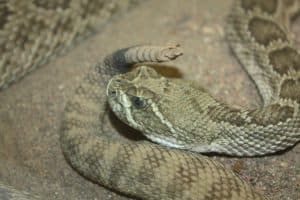
Like to be left alone
There’s no question that prairie rattlesnakes would prefer to simply not be seen and have you leave their area rather than have a confrontation, however there is a very healthy population which means that sometimes human-snake interactions are going to be inevitable.
Prairie rattlers will often stay still even if you’re within 10 or 15 feet if they feel like you can’t see them, and you’re not heading directly towards them.
In fact, many people who live in prairie rattler territory who claim to have never seen one would probably be surprised how often they’ve been close to one – assuming they hike, walk, farm, or spend time out in the wild anywhere that would be considered rattler country where prairie rattlesnakes might be found.
Most snake bites happen from accidental contact, especially when stepping over a downed tree or log, or climbing a rocky area. Others happen from too much drinking and idiots thinking it would be a great idea to bother these rattlesnakes instead of just giving them some open space they can use to leave or escape.
Two recognized sub-species of prairie rattlesnakes
Currently there are two recognized sub-species of the prairie rattlesnake still found throughout the United States. One is much more common than the other, at least when it comes to running into people because of encroachment on its territory.
First of all, there is the classic Prairie rattlesnake, given the scientific name of Crotalus viridis viridis back in 1818. This is the classic rattlesnake many people think of when they hear about a prairie rattler. Found throughout the northern great plains of the U.S. (mostly the Dakotas) and a section of the Rocky Mountains in force, they also pop up here and there in isolated pockets in a surprisingly large area that stretches from some of the current prairie region of Canada throughout the Rocky Mountains and even into northern Mexico.
Then there is Crotalus viridis nuntius which was officially recognized in 1935 as a scientifically separate sub-species and goes by the better known name of the Hopi rattlesnake. Given this name because they are mostly found in a north central Arizona and New Mexico area, one that consists of the large Hopi Reservation, this sub-species of prairie rattler is less often tripped upon.
They have healthy populations in their area but often live in places where very few humans do, allowing the two groups to generally leave each other alone.
Great articles/resources on Prairie Rattlesnakes:
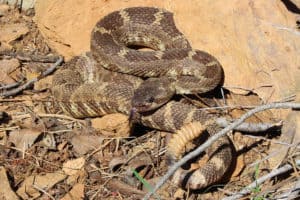
Western Rattlesnakes
Western rattlesnakes are a large group with multiple sub-species that all come under this one general group. In fact, there are 5 different recognized subspecies of rattlesnakes that are found throughout the United States and as you would expect based on the name, these are mainly found from the Rocky Mountains on west into the Pacific Northwest and California.
While the East and the South have plenty of venomous snakes to watch out for, it’s hard to compete with Texas, the Rocky Mountains, and the West Coast when it comes to variety and numbers. Plenty of heavy woods, deserts, and true wilderness that hasn’t been encroached on offer a variety of natural habitats where large populations of these venomous snakes can (and do) thrive.
This only makes sense considering many of these areas were the last to be “civilized” or settled by large populations by the United States, and many of the largest wild areas in the Lower 48 are still out in the West, giving them plenty of space to thrive. With that in mind, let’s get to the five recognized sub-species of Western Rattlesnakes found throughout the western part of the United States!
Five different subspecies of Western Rattlesnakes in the U.S*:
- Northern Pacific rattlesnake (Crotalus oreganus)
- Southern Pacific rattlesnake (Crotalus oreganus helleri)
- Grand Canyon rattlesnake (Crotalus oreganus abyssus)
- Great Basin rattlesnake (Crotalus oreganus lutosus)
- Midget faded rattlesnake (Crotalus oreganus concolor)
*There are, in fact, seven sub-species of Western Rattlesnakes although two of them are found native only in Mexico. Since the focus of this article is venomous snakes found in the United States, these five are the only ones we’re going to focus on.
The Northern & Southern Pacific Rattlesnake
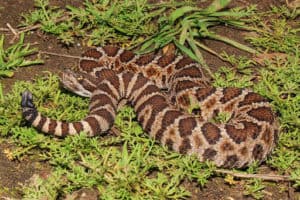
The Northern Pacific Rattlesnake is a fascinating species of the common American pit viper, because they are widespread yet individual populations seem to really take on different directions in evolution based on the surrounding area.
Found on the area known as “The Pacific Slope” from as far north as British Columbia, Canada, all the way down through California and east into Oregon, and Idaho.
There are several localized populations of these venomous snakes and some isolated groups can grow to twice the size of other groups of the very same species! They blend in well with local forests and while they stick out a bit as young or juvenile aged snakes because they often have a pink coloration that fades over time.
As adults most will be dark gray, dark brown, olive brown, or yellow with large brown blotches. Once again these minor differences often depend on the local population location and the genetics in that specific area.
Generally speaking a large number of lateral blotches will be visible on most of these snakes, and the pattern is really easy to spot once you know what to look for.
One of the other interesting things about this particular sub-species of rattlesnake is how adaptable they have proven to been, and isolated populations of this species have even been found thriving on six different islands (although on some of the now more heavily settled ones they are much harder to be found).
Those six islands are:
- Anaho Island located on Pyramid Lake, Nevada
- Mare Island off of Vallejo, California
- Morro Rock in Morro Bay, California
- Rattlesnake Island in Clear Lake, California
- Santa Catalina Island off the San Pedro Coast
- South Coronado Island off Baja California Coast
That is one adaptable species of rattlesnake.
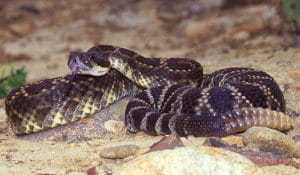
The Southern Pacific rattlesnake is a similar sub-species, but sometime in the upper to middle part of the state and the Sierra Nevadas you see a switchover from the northern rattlers to the southern ones.
The South Pacific Rattlesnakes tend to be much darker in color. Known under the scientific name of Crotalus oreganus helleri, and are particularly thriving in the many desert areas in the southern part of the state of California, and they also thrive into Baja California and northern Mexico.
If you hear people warning you to look out for black diamond rattlesnakes, they are talking about South Pacific rattlers, just calling them by a popular and common nickname. As long as you give these guys a wide berth you shouldn’t run into too many problems – most of these snakes simply want their space and want to be left alone.
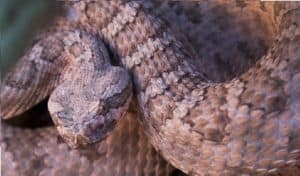
Grand Canyon Rattlesnake
The Grand Canyon rattlesnake is pretty easy to figure out, when it comes to general area. If you’re still somehow confused, this map of recent confirmed sightings shows why this name would definitely still pass the truth to advertising standard.
This particular sub-species of rattlesnake has a variety of colorations that help it really blend into the local area. Red, yellow, green, and light tan are all very common. There are some that have hints of gray, while many even have distinct red and pink coloration – in fact “Grand Canyon Pink Rattlesnake” is a common name used to describe this species.
The Grand Canyon rattlesnake (Crotalus oreganus abyssus) is a true example of an isolated population that has adapted incredibly to one very particular area and has more or less managed to continue to enhance those traits through natural selection to the point of being very distinctive and easy to recognize as their own sub-species of the Western Rattlesnake.
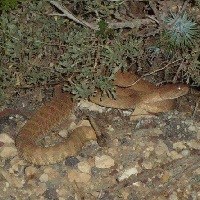
While Great Basin Rattlesnakes and midget faded rattlesnakes can both be found close by, as well, the Grand Canyon Rattler can only be found in northern Arizona in and around Grand Canyon National Park in northwest and north central regions of the state.
This is a larger rattlesnake, maybe not compared to a really large diamondback but adults can range from as small as 16 inches for young ones up to just above four feet long (54 inches) for older full grown adults.
These might seem like strange color combinations but against sand, sandstone, and the particular light and colors of the plant life, stones, and ground in the Grand Canyon park area, they blend in amazingly well and also have a reputation for being remarkably calm for a rattlesnake, meaning many a time a person has passed surprisingly close without hearing a rattle or even knowing the snake was there.
These snakes are normally diurnal, meaning they are active in the daylight as opposed to night, but when conditions are right. If it’s a warm night instead of a really cold one, they might be out and about. These rattlesnakes are found throughout the many habitats in and around the park including grassland, scrubland, canyon bottoms, the hills, the woodlands, the pines, and more. Keep an eye open for this adaptable local species and respect their space if you see one.
They might be pretty calm by nature, but you don’t want to push them too far!
Great Basin Rattlesnake
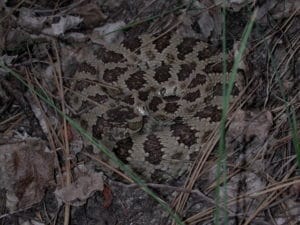
This sub-species of the Western Rattlesnake has a reputation among many herpetologists and snake enthusiasts as being some of the most beautiful rattlesnakes out there, but also some of the hardest to photograph because they are so calm and shy – very very rarely ever showing even a defensive based aggressiveness.
They still need to be treated with the same respect as other venomous rattlesnakes, but the Great Basin rattlesnake’s (scientific name: Crotalus oreganus lutosus) reputation, and the fact that many times this particular snake makes for very pretty pictures, makes it a favorite of many conservation enthusiasts.
Growing up to an impressive 64 inches, this is a large rattlesnake that can can grow quite large and featured keeled scales meaning they’re not the flat and smooth scales many other rattlers feature. They can be found from southwest Oregon down into northeast Arizona, making them a sub-species of Western Rattlesnakes that have absolutely thrived.
The coloration on these rattlers can vary immensely. Some re very light, composing of mostly off-white, yellow, and tan, while other specimens will be gray, purple-gray, or even a gray and light pink mix. Most of them will have dark bars on the face that extend back, and they are often found overlapping with other sub-species of Western rattlesnakes as well as other rattlesnake species out West.
Great Basin rattlers are extremely impressive specimens and it’s not hard to see why snake enthusiast conservationists out West are such fans.
More resources worth checking out:
- Absolutely AMAZING article on Great Basin Rattlers
- National Park Service Article on these rattlesnakes
Midget Faded Rattlesnake
The midget faded rattlesnake goes by many names, but it is a small rattler that packs a big punch. The smallest of the sub-species of Western Rattlesnakes, the midget faded rattlesnake (scientific name: Crotalus oreganus concolor) also contains the most toxic venom among the Western Rattlesnake sub-species, making it a living example of the idea that big impact can come from little packages.
Also known as a yellow rattlesnake or a yellow faded rattlesnake, the distinctive coloration makes them really stick out compared to other species of rattler, though there are individuals that have light pinkish tan or light gray as opposed to yellow. Reaching a full sized adult range of 16 to 26 inches, they are rather easy to make out compared to the other sub-species of Western Rattlesnake found throughout that part of the country.
Younger midget rattlers have very clear blotches and markings while those distinctive marks fade as the snake grows older into adulthood. There are many specimens that appear silver and grayish in colors by the time they are fully grown.
This species of Western Rattlesnake is found throughout the Colorado River and Green River basins which means they’re found throughout a limited area that includes east Utah, west Colorado, and southwest Wyoming.
A shy species of rattler
This is a very comparatively shy species of rattlesnake, which really tries to avoid confrontations with people and is much more likely to take off running rather than attack even when feeling nervous or crowded. However, it’s still important to know that these snakes have a particularly toxic venom and a bite from one of these small rattlesnakes is a very serious issue that requires immediate attention.
While they’re not as aggressive or potentially aggro as other high venom species of rattler like the tiger rattler or the Mojave Rattler, their bite can still pop quite a wallop. Commonly found in handholds and between stones or under the shade of larger desert rocks, make sure to watch where you are climbing, walking, or exploring when you hit the desert regions this snake calls home.
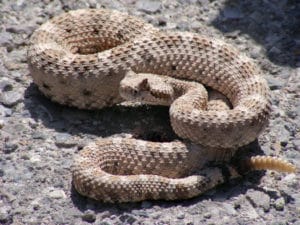
Sidewinder Rattlesnakes
Also referred to as a horned rattlesnake because of two very visible protrusions on the head that look like a pair of small horns, one above each eye. Interesting enough with that distinctive look, scientists actually aren’t 100% sure what those unique protrusions are actually for although there’s a theory accepted by many biologists and herpetologists that this might help keep sand out of the eyes when they bury themselves in the sand for ambushing prey.
Sidewinders are also among the most understood species of rattlers as they have a “common wisdom” reputation for being especially aggressive or dangerous, but the facts actually do not back up this picture. Sidewinder rattlers tend to be extremely calm by nature and will go with the option to leave or hide almost every time over attacking or even taking an aggressive stance.
Their reputation could come from being mistaken with the Mojave rattler (a much more aggressive species) in the wild, or from the sidewinder movement they’re named after – which can lead to incredibly fast movement across the sand and might be mistaken for moving towards a person to attack when they’re merely darting past for a favorite hiding place.
Found mostly in the American Southwest, mostly in Arizona, California, and Nevada although small sidewinder habitats exist in a section of southwest Utah. These are smaller sized rattlesnakes who tend to be more solitary by nature, and their venom isn’t all that dangerous to humans compared to many other rattlers.
This is due in part to their small size meaning less venom is injected in a bite along with the fact that the venom itself is simply much less toxic than that of many other rattlesnakes found in that area of the desert.
Be cautious and be smart
Now all that being said, you still need to be careful when desert hiking and especially when going through heavily rocky areas in this region. While a sidewinder rattler bite will very rarely be fatal, it still needs to be taken seriously and the best first step to avoiding the excruciating pain is to be aware and be smart.
Give these guys a little bit of space and they’ll be happy to stay out of your way. Definitely one of my favorite species to research online because of their fascinating habits, many great videos, and frankly they’re one of the few rattlesnakes that seemed relatively “chill” on video even when being handled or just after being handled.
More great resources on sidewinder rattlesnakes:
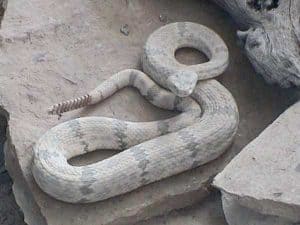
Rock Rattlesnakes
Rock rattlesnakes are another species that are found primarily in the southwest and into Mexico, and you can tell with just a picture of a two why they are appropriately named. Their coloration allows for an amazing amount of camouflage in natural rocky and desert settings, allowing them to thrive in their natural habitat.
There are actually four sub-species of rock rattlesnakes, all of which are found in northern Mexico but only two of which are found in the United States (and hence the only two we will focus on in this article). Those two sub-species are the:
- Banded rock rattlesnake
- Mottled rock rattlesnake
This is a middle sized rattlesnake that doesn’t tend to get very long, with even the largest of full grown adults rarely hitting 32 inches in length but they are very thick in body, giving the impression of being even larger than they actually are. Found in the very southern sections of west Texas, New Mexico, and Arizona, they are mostly nocturnal by nature and like to live among rocky outcroppings – another reason for their name.
Not aggressive but…
These are some of the least aggressive of the rattlesnake species, with many of them choosing to stay hidden and not even rattling as long as you keep a respectful distance and don’t startle them. They are all about the camo and staying hidden. In fact, they have such a reputation for being docile that they often appear in zoos or are in high demand in the exotic animal trade.
That being said, they do have a bite first instinct if a foot suddenly drops right beside them “out of nowhere” or they get stepped on. This can give a reputation for aggression, but it has to be an incredibly specific and unusual situation to end up with this reaction. These might be the most docile species of rattlesnakes…but that doesn’t mean you should handle them or harass them.
They are still venomous snakes – and they will go to that bite instinct to defend themselves if they have to. Their venom is mostly hemotoxic, but in some tests they have shown some signs of neurotoxic effects, as well, meaning these bites can be seriously bad news – thankfully the snake’s shyness and out of the way habitat means these bites will be incredibly rare.
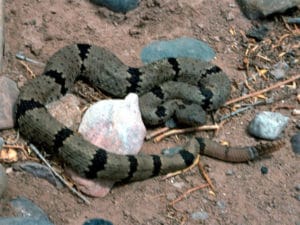
Banded rock rattlesnakes
The banded rock rattlesnakes (scientific name: Crotalus lepidus klauberi) aren’t large rattlesnakes at all: in fact this sub-species rarely sees fully grown adults that are more than 2 feet in total length. They are so named because of the clear and distinctive bands around their body as well as their strong tendency to be found among rocks and rock outcroppings.
In fact, they are rarely found elsewhere!
Also known as a blue rattlesnake or a green rattlesnake, some isolated populations of these snakes have incredibly unique or different coloring. While a light gray body with dark gray bands tend to be the basis, in some places the main color is green and in others purple. This seems really heavily dependent on what exactly the normal rock coloration is in the area, and this has led to some really unusual isolated populations.
For example, if you travel to El Paso County in the state of Texas, you’ll find that the population of banded rock rattlesnakes found in the Franklin Mountains have a really sharp and unique silver & pearl main coloration, separated by sheer black bands across the pearl/silver body.
Still plenty of controversy over this sub-species
Not all sub-species of rattlesnakes are clear cut. In fact, the banded rock rattlesnakes are a classic example of this! Even among professional herpetologists there are many disagreements about how to properly identify them from other sub-species of rock rattlesnakes. The number of bands, stripes around the eyes (or lack thereof) mottling between bands, and coloration are all ways that have been used and while there are some general rules of thumb for identifying this sub-species compared to its closely related cousins, as always there will still be some exceptions.
Very rarely seen
This rattlesnakes rarely run into people, in large part because they are nocturnal and are especially likely to be found in cliffs, caves, rock formations, caverns, and other similar rocky outcroppings. Add in the camo and their generally shy nature and it’s not hard to see why this particular rattler can often fly in under the radar.
Even more interesting is the fact that researchers have found out that these snakes may have the smallest average habitat of any studied venomous snake found in the United States. These serpents very rarely travel very far and many seem to spend their entire life on one slope, cliff, or rocky outcropping.
When they are seen, usually it’s during or right after a warm thunderstorm when they’re out and looking for prey or enjoying the rain, or by individuals looking for them at night.
One interesting exception
While these rattlers are known for being incredibly docile, there is one small known population of them that bucks this trend and actually is very aggressive and stand-offish against human intrusion!
This group is found in the Organ Mountains in southern New Mexico, particularly the dens found higher than 7,000 feet up. Unlike their shy brethren that like to hide and rely on camo to the point of often not even rattling when people are close by, these rattlers tend to be very defensive, rise up in threatening poses with plenty of confidence, and the mere sight of humans will cause them to rattle consistently without ceasing until everyone leaves.
Why is this one population is so violent towards people? No one knows but if you’re ever hiking in this region don’t assume that rock rattlesnake is docile – you may be in the one place where they’re really not!
Interesting historical fact: The scientific name of this rattlesnake is in honor of renowned rattlesnake specialist Laurence Monroe Klauber (1883-1968), a pioneer herpetologist of great influence. Learn more about him HERE.
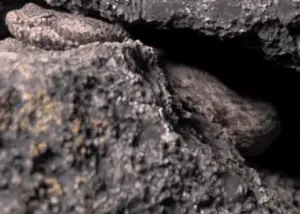
Mottled rock rattlesnakes
The other sub-species of rock rattlesnake found in the United States, these are found in southern New Mexico and Texas, but not in Arizona. Local populations will generally have an amazing ability to match the nearby rocks, with the mottled patterns they are named for giving them a level of cover to blend in that is hard for even other well camouflaged rattlesnakes to match.
These snakes can be heavily gray, brown, green, pink, blue, or even blue-gray. Blends of these colors will depend on the nearby rocks as once again, these rattlesnakes are all about the natural camo and rarely come out from the many cracks and crevices between rocks. Those are the places they live, wait in ambush for prey, and hide. Because of that, there are very few snakes that will blend in this well – and it’s also a reason that off the beaten path rock climbers and hikers in this region need to be very wary!
A great video showing several pictures of these guys, and multiple coloration patterns by Orry Martin, can be found HERE, and man – at the end of this video just look at the way they all blend in!
Great video to check out, and really fascinating rattlesnake.
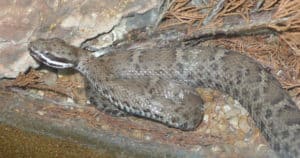
Ridge Nose Rattlesnakes
This rattlesnake has the smallest natural ecosystem area of any rattler found within the United States, although there are large populations through northern Mexico, as well. Found only in the smallest sliver of southwest New Mexico and the bordering tiny area of farmost southeast Arizona, the ridge nose rattlesnake is considered a threatened species in the state of Arizona, and as such is protected by law.
Ridge nose rattlers are going to be one of the hardest species to run into in the States because of their “barely there” presence within the borders. The habitat map on the ridge nose rattler Wikipedia page shows just how little a toe hold this beautiful snake has within the United States.
Named for the scales near the ridge of the nose that upturn into a distinctive facial feature, highlighted by the white facial stripes, and creating a sort of snout. These are very small rattlers that pretty much never get larger than two feet in length. They are opportunistic predators who eat a lot of centipedes and small lizards.
These rattlers don’t have particularly strong venom, and they are not known for being very aggressive at all. They prefer to hide and blend in very well with the local area, meaning even people looking for them have often walked by, not knowing one was within a few feet. There are no recorded deaths from these rattlesnakes, and it’s hard to even find a confirmed bite.
As one herpetologist I talked to said, “They’re pretty chill.”
Fun fact: This rattler is sometimes called a Willard Rattlesnake, after Frank Willard, a businessman who discovered this species in 1905.
Speckled Rattlesnakes
Speckled rattlesnakes are another one of those species that can be found throughout the southwest desert sections of the United States, dipping into the connected deserts of north and west Mexico, as well as Baja California. There are actually 5 fully recognized species of speckled rattlesnakes, but only two of which are found in the United States.
Fun Fact: One of the sub-species of speckled rattlesnakes is only found on an uninhabited island off of Baja California: Isla El Muerto which translates to “The Dead Island” – isn’t that freaking cool?
Since we’re focusing only on venomous snakes that are native to the United States, that means for this entry we’ll only be looking at two sub-species of speckled rattlers:
- Southwestern speckled rattlesnake (Crotalus mitchellii pyrrhus)
- Panamint speckled rattlesnake (Crotalus mitchellii stephensi)
These are the two sub-species that are found in the U.S. in the states of California, Nevada, and Utah, depending on which of the two you’re specifically looking at.
This is a small to medium sized rattlesnake with the absolute largest ones generally hitting 32-26 inches. They tend to thrive in rocky areas around desert regions and are most likely to be found in those regions.
Read on to learn more about each of the sub-species that are found in the United States.
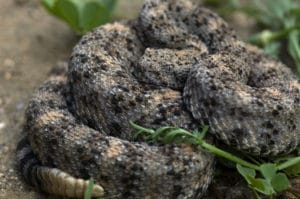
The Southwestern speckled rattlesnake
A mainly nocturnal snake, the Southwestern speckled rattler is found throughout rocky outcroppings, mountains, and rocky areas throughout the Southwestern United States. They have adapted to really blend in with the local rocks, so a population at one rock outcropping could have very different patterns and appearance from a population of the same sub-species that is found elsewhere.
These snakes have a very wide range of coloration because of the same variance in desert rocks and rock outcroppings. The base colors for this sub-species vary widely and can include brown, gray, pink, yellow, or even white. That is a pretty huge range of colors when you think about it!
Add in white and black speckles and a ringed tail and the comparative pictures of this sub-species are going to often highlight a wide range of differences.
These variations in appearance also help explain the many, many nicknames that this sub-species of rattlesnake has, with the most common ones including but not limited to: bleached/pale rattlesnake, white rattlesnake, red rattlesnake, and speckled rattler.
While many rattlers in these regions will focus on small lizards, centipedes, and other similar animals, this speckled rattler very much prefers small mammals.
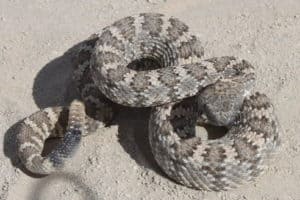
Panamint speckled rattlesnake
The panamint speckled rattlesnake, often simply referred to as the panamint rattlesnake or panamint rattler (other common nicknames include the Owens Valley rattlesnake and some call it a tiger rattler, although this last one is incorrect as this sub-species is not the same as the tiger rattlesnake), this sub-species of speckled rattlers can be found in south central Nevada as well as the bordering sections of the state of California.
These aren’t particularly huge snakes as the fully grown adults generally range from two feet to three feet in length (24 inches to 36 inches) and the color patterns combine brown, gray, tan, or red-brown shades. Combinations of the two color patterns make for a snake that is especially good at blending in with stone and sand surroundings.
Most often found at elevations of 3,000 feet to 9,000 feet, these snakes are commonly found in the mountains between the two states of Nevada and California, the panamint rattlesnake feeds on small lizards, birds, and mammals and they are relatively shy in comparison to more aggressive forms of rattlesnakes.
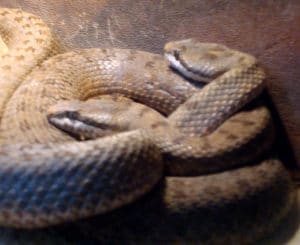
Twin Spotted Rattlesnakes
The twin spotted rattlesnake is a smaller rattlesnake with adults averaging only a foot and a half (18 inches) in size, and maxing out at two feet in length at the largest (24 inches). Only found in really isolated areas in high altitude pine forests in eastern Arizona, and especially southeast Arizona. They are really run into by accident because of their habitat being mostly very isolated areas, and there are actually no known fatalities from their bite.
These are relatively docile rattlers that like to be left alone and while they can be active during all four seasons, they are much less active during the winter and would generally only be found when they are sunning during a really unusually warm and sunny day.
Known by the scientific name of Crotalus pricei, the picture shows two that are definitely more on the pinkish and light gray side of the spectrum when it comes to coloring, many are found on the darker gray or even light brown side of things, but the very distinctive spotted pattern remains, hence their common name.
Very rarely found below 6,000 feet, these venomous snakes basically are only found in four separate distinct mountain areas. They are mostly diurnal by nature and if encountered you should freeze, give them space, and let them be on their way.
They are protected by the state of Arizona.
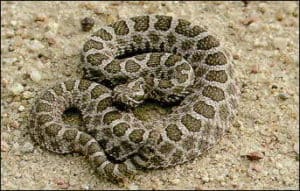
Massasauga Rattlesnakes
The Massasauga rattlesnake is particularly unique because the type of venom it has is distinctly different from the type of venom you will find in other rattlers. The Massasauga population is spread from Michigan to the Texas coast and western Arizona in a downward diagonal swath throughout the entire United States. This is a unique situation as it sets up the fact that Massasauga rattlesnakes can be found throughout the country in a wide variety of states yet are considered threatened or isolated in many of those areas since human encroachment in their territory has led to more and more isolated populations.
As for the venom: unlike most rattlesnakes the venom that is injected from a Massasauga bite is cytotoxic and will actually destroy the tissue of the individuals. This leads to many of the really hard to look at pictures of limbs with necrotic flesh and damage (we won’t be linking to any of those – they’re easy enough to find if you look). While this makes their bite very feared, like most rattlesnakes they tend to be shy creatures who would prefer to be left alone, but it shows the incredible need for fast and effective medical treatment in the case of a bite.
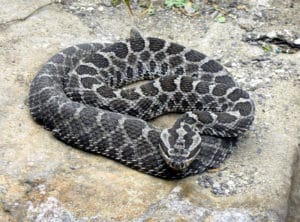
Normal appearance & general facts
Although widespread, the massasauga isn’t really that big a rattlesnake by comparison. They are far smaller than timber rattlers or either species of diamondback, but they are considerably bigger than your pygmy rattlesnakes or the twin spotted rattlers. Fully grown adults tend to be 24 to 30 inches in length and very rarely appear any longer than that. They aren’t especially wide or thick, but just a pretty average size for a rattler.
Most are either gray or tan as a base color, which is usually determined by whatever color tends to be the best camouflage for that specific area. These are broken up by large brown or black blotches that go all the way down the back. There are some isolated examples of populations that tend to be an incredibly dark gray along with large dark brown blotches that can mix to create a color pattern that looks mostly brown or black with a few shade differences throughout.
These are lower elevation snakes that are almost always found below 1500 meters (approximately 4500 feet) in elevation and can be found in virtually every type of ecosystem that stretches from Ontario across the United States down into the deserts of Texas and the American Southwest.
Because of how many different regions they are naturally found in, they are also the species of rattlesnake that by far and away has the most nicknames or “common names,” with well over 20 different nicknames including some that are extremely regional like “gray rattlesnake” in the state of Iowa or Michigan point rattler in the state of Michigan
Bringing home the fact they are far reaching but often isolated in groups, most residents of the state of Iowa aren’t even aware that the massasauga rattlesnake can be found in the state, in part because they are only three tiny populations found in three distinctive marshland areas, and nowhere else throughout the entire state.
Widespread, but heavily threatened
One unique feature of this particular species of rattlesnake is that it is considered heavily threatened or endangered in many places. As previously mentioned, there are only three very small and isolated populations in three separate small marshes in the state of Iowa, where they are endangered. The eastern massasauga sub-species in particular is under particular threat in multiple states, to the point it has actually been seen as a candidate for the federal U.S. recognition as an endangered species.
The massasauga is not only up for federal listing as a potentially endangered species, but it is already listed as threatened in Ontario under that province’s Endangered Species Act. They are protected in many of the areas they are found and is becoming increasing rare in Canada because of popular community development in areas this snake calls home. Developing lakefront property might be good economically for a community, but it isn’t always good for the area’s natural habitat.
There are 3 distinctive recognized sub-species of the massasauga rattlesnake, which are:
- Eastern massasauga rattlesnake
- Western massasauga rattlesnake
- Desert massasauga rattlesnake
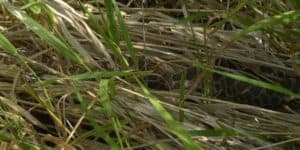
Eastern Massasauga Rattlesnake
While this sub-species is responsible for the eastern, north, and center part of the “wide habitat range” but there’s one big problem with that perception: this sub-species is heavily endangered. In fact, they are considered threatened or endangered in every single state and province they appear in other than the state of Michigan, where they still are considered a “species of concern.”
This means they are endangered in:
- Iowa
- Indiana
- Illinois
- Minnesota
- New York
- Ohio
- Pennsylvania
- Wisconsin
This is in addition to being considered threatened in the Canadian province of Ontario and they are actually considered locally extinct in Missouri. There might be a lone one here or there, but they have escaped detection and there is believed to be no more healthy breeding populations in the wild.
Once healthy and spread throughout the country, this sub-species in particular has really struggled in modern times.
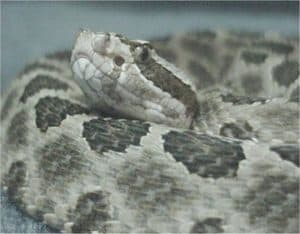
Western Massasauga Rattlesnake
The western massasauga rattlesnake is found in the central to south states in territories that were more known for being in the southwestern plains. Ranging from as small as 14 inches to as long as 36 inches, they look extremely similar to the eastern massasauga but generally just a bit paler in color.
These are found in the States from the very extreme edge of southeast Nebraska through northwest Missouri (where the eastern sub-species is considered extinct), down through Kansas, Oklahoma, and even northern and central Texas. You can find them in grasslands, at the edge of forests and woods, and even some rocky hillsides.
They mostly eat rodents and small lizards & frogs, and are generally shy in nature, preferring not to be seen by people or interact if possible. One distinct trait about this rattler is when they get uncomfortable and start rattling in warning, the rattle is much faster and creates a much faster (higher) pitch than what other rattlesnakes create.
This makes the noise sound like a really high pitched buzz, which is why some individuals call these rattlers a “buzz rattler” or “buzzing rattler.”
Generally nocturnal, they are most often found by people after a rain when its a bit cooler and they’re out and more active in the right post rain temperatures.
Their venom, drop for drop, is considered among the most potent out there between rattlesnakes however the massasauga also delivers lower yields of venom per bite than most large rattlers, so the overall effect is often less harmful. That being said, this is a strong hemotoxin type of venom and anyone who gets bit needs to seek medical treatment immediately.
Untreated bites can lead to necrosis killing the skin and flesh, so fast treatment is critical.
As an interesting note, this sub-species has been known to interbreed with the desert massasauga in places where the two sub-species overlap.
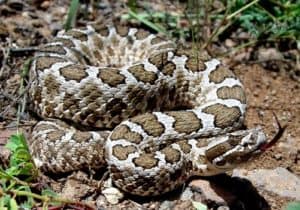
Desert Massasauga Rattlesnake
This is the smallest of the massasauga rattlesnakes, with the largest adults only reaching around 21 inches. They are found throughout sections of the southwest United States and actually their ecosystem continues down into the deserts of northern Mexico in some places, as well.
These are a rather slender and small rattlesnake, not very large in size compared to the other sub-species and even less when compared to some of the larger species of rattlesnakes that are out there. They are known for having a particularly high pitched rattle that sounds like a loud buzzing sound (hence the nickname “buzztail”).
This sub-species is found in Arizona, New Mexico, and a portion of western Texas and in places where they overlay with the western massasauga rattler the two sub-species will occasionally intermix. However, true to their names, these desert rattlers are most often found in desert grasslands, especially those arid and semi-arid areas.
These nocturnal snakes are most often active at night and often find the day too hot although at the right time in the morning or a cooler than normal day they can occasionally be found sunning themselves.
This snake is considered threatened in both Arizona and Colorado where populations are small, isolated, and threatened.
More resources on the Massasauga Rattler:
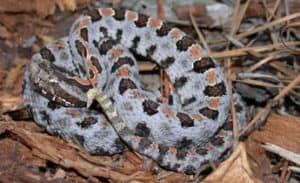
Pigmy Rattlesnakes
One of the smallest rattlesnakes out there, the aptly named pigmy rattlesnake can still pack a punch in the wrong conditions. These little guys have no problem being David and slaying a larger Goliath, though as with many rattlers they are shy by nature, and the smaller stature of these pit vipers makes them even more inclined to seek shelter as opposed to conflict, but their small size can also make it easy for a person to get too close without spotting them.
These small rattlesnakes are aptly nicknamed because they only get 14-22 inches in length, and not any bigger. That is a far cry from Diamondback rattlers who can get 6-8 feet in length or even more in some extraordinary circumstances.
Belonging to the Sistrurus genus of rattlesnakes, and aside from size these snakes have other traits appearance wise that really sets them apart from others. This includes large scales that actually appear on the top of the head and its rattle is so small that many people actually can’t hear it rattle as a warning.
This makes keeping the eyes open for this little guy even more important when you’re out in his ecosystem!
Three sub-species: appearance may vary
Appearance wise the strong defining traits when it comes to appearance is the small size as well as the scales on the head and barely developed rattles. Color wise these guys can vary enormously from one region to another. Some appear mostly gray in color, some are even mainly lavender in color!
First of all the sub-species:
- Dusky pigmy rattlesnake (Sistrurus miliarius barbouri)
- Carolina pigmy rattlesnake (Sistrurus miliarius miliarius)
- Western pigmy rattlesnake (Sistrurus miliarius streckeri)
These are easy enough to figure out. The Dusky and Carolina sub-species of pigmy rattlers are found throughout the South, generally to the east of the Appalachian Mountains while the Western pigmy rattlers are going to be found to the west of the Appalachians.
These subspecies tend to sport a colored bar from the eye to the base of the mouth, which runs from reddish brown to a dark black. Most will also have an orange/reddish-brown dorsal stripe that helps to identify them. Babies may have a bright yellow at the end of the tail, and all of them are going to have white bellies that are decorated with dark spots.
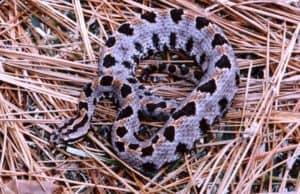
The Carolina Pigmy Rattler
A rattlesnake with a versatile look, when you’re on the lookout for Carolina pigmy rattlers throughout South Carolina and northern Georgia you’ll need to really keep an eye out because this sub-species can be gray, lavender, or tan in nature depending on the local population group.
There are even some in isolated areas that are orange or red in nature to blend into the mud and stone. It is very possible to have several Carolina rattlers together that look like different species based on wildly different coloring – but the similarities mentioned in this article will be there.
An important note: these snakes absolutely LOVE gopher tortoise burrows. So don’t go sticking your hand down any dark holes (which is generally good advice anyway). They are most commonly found living in pine forests and sand hills, so be doubly cautious when you find yourself in those environments.
Because of their small size they can be really hard to spot, especially if waiting in grass or leaves to ambush prey, so don’t go rooting around with bare hands – just not a good idea in their habitat!
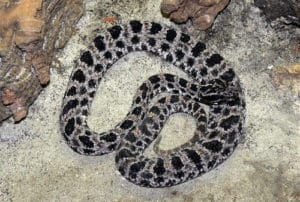
The Dusky Pigmy Rattler
The dusky pigmy rattler will tend to have less of a variety in its coloration, though these can still go from a dark bluish gray all the way to a heavily black coloration. These are mainly found in the southern coastal plains and the populations tend to be very healthy and large where they are found, though those populations tend to be scattered.
You are going to find these little guys around watery areas like marshes, swamps, and creeks. While they can be in surrounding areas, especially in woods, just be aware that these are the types of environments where they can thrive and are also more likely to be run into.
While these small rattlesnakes tend to be generally too small to deliver a particularly deadly bite to a healthy adult, you still need to make sure to get medical treatment to help insure a full recovery if you do find yourself bitten.
The Western Pigmy Rattler
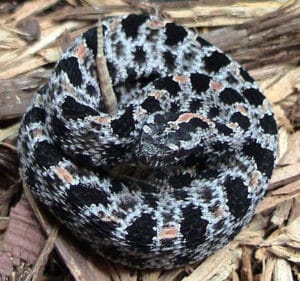
The Western pigmy rattlesnake tends to stay on the gray to brown side of things, with darker spots that can be black. On the head you’ll notice some very distinct crossbars with spots on both sides.
This is the western most of all the pigmy rattlesnakes and can even be found as far out as eastern Texas and Oklahoma. They can also be found as far north as Tennessee and Missouri while being found throughout a good chunk of the South, as well.
Generally speaking these have a gray belly as opposed to the white bellies many of the other pigmy species have, or can be a really dusky cream type of color. The tiny tail will sometimes have a distinct rattle but like its small cousins because of the relatively small size of this particular pit viper, the rattle may sound like a loud insect buzzing and can easily be mistaken for something other than a snake warning.
Throughout parts of the lower Midwest, these snakes are very commonly referred to as ground rattlers. If you hear someone talking about watching out for ground rattlers, they are almost certainly referring to referring to Western pigmy rattlesnakes.
Pigmy rattler round-up
All three of these small sub-species of rattlers like to stay hidden among leaves and ground little, and they are all about the ambush. Great for eating, but being that hidden also means a lot of bites because a person simply isn’t aware that they’re there until it’s too late. These snakes are often also seen crossing the road in the evening during summer when its warm but not too warm, and they are definitely one of the more unique rattlesnakes found in the United States.
*Multiple pygmy Rattlesnake pictures taken by J.D. Wilson and used from the University of Georgia found at https://srelherp.uga.edu/snakes/sismil.htm
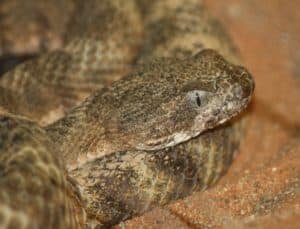
Tiger Rattlesnakes
A very fitting name for a rattlesnake that is powerful, has no sub-species to its name, and stays out of the way of humans as much as possible. Although there might be some comparisons between the power of the giant cat it’s named after and how these rattlers compare to other species and sub-species of rattlesnake, the most distinctive feature are the vertical crossbands that give the appearance of black stripes going up and down the entire body. Most have a full 35-50 of these “stripes” that give them their very distinctive look.
Many people haven’t heard of this species, and it’s not hard to understand why seeing as how they exist only in a very small area overall in North America, and doubly so when looking at where they can be found in the United States. Tiger rattlers can only be found in the south central section of Arizona in the U.S., and a bit further south in northwest Mexico (mainland, not Baja California).
That being said, it’s hard to argue that they’re not king of their roost in comparison to other snakes where they’re at.
Average Appearance
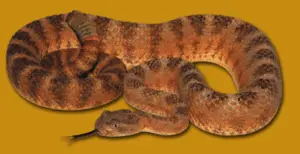
Tiger rattlesnakes have relatively small heads, sharp and spade-shaped in appearance as opposed to the very wide triangular head of many other species of large rattlesnakes. In fact, the average head of a Tiger rattler is a mere 4% of its total length and that makes it the smallest head of any rattler.
Colors vary, but gray, blue-gray, lavender, pink, and even pale orange or cream white. Another reason this rattlesnake definitely fits its name.
Aside from great camouflage that helps them blend in, you aren’t likely to run into tiger rattlers as often because they are nocturnal during the summer. Although they may be more diurnal during non-summer and non-winter seasons, they also will stay heavily crepuscular when the temperatures are right, and although very much a land based snake, they can still swim and make their way through low ground bushes when necessary.
The most likely time to run into them is during March to October, especially after a warm rain on not too hot days or nights.
A reputation for being aggressive & dangerous
Although among one of the more mysterious species of rattlesnakes in the United States because so little is known concretely about them, they do have a reputation for being among the more dangerous and aggressive, and that reputation is not completely unfounded.
While like any rattlesnake they would rather just be left alone and bites on humans are very rare, tiger rattlesnakes are known for being excitable, easily aggravated, and quickly turn aggressive when feeling threatened. In fact the word “cantankerous” would not be far off the mark.
In addition to this, the tiger rattlesnake is considered to have among the most toxic of all venom, even compared by many measurements to the Mojave rattler. Their venom is known to contain a unique myotoxin as well as a neurotoxin similar to said Mojave rattlers. While there’s some disagreement on whether the Mojave venom is more dangerous to humans or the tiger rattler venom is more dangerous, the two are basically 1A & 1B when it comes to potency of rattlesnake venom.
What does this mean? It means a bite from a tiger rattler can cause muscle necrosis in addition to causing severe neurological problems. In other words, it’s a bite that really can pack a dangerous punch, and anyone who is bitten by a tiger rattler needs to seek medical attention and antivenom treatment immediately.
There aren’t many records on people bit by tiger rattlers, and the small amount of venom produced and dry bites could explain a lack of severe cases or deaths, but nonetheless these beautiful but potentially deadly snakes need to be fully respected and should not be handled by anyone other than professionals.
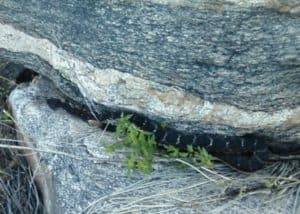
Arizona Black Rattlesnake
The Arizona black rattlesnake is found in the Southwest and as the name indicates it is primarily found in the state of Arizona, although a few have been found in Steeple Rock, New Mexico, an area that is in the extreme western most part of the state where it borders Arizona.
Noted for their dark color, this is a snake that will continue to darken and get blacker the older it gets. Younger ones will often have bright stripes that fade over time as they age. This is a relatively small rattlesnake with adults usually ending up in the 30-40 inch range, and they are not especially thick bodied compared to many other species of rattlesnake that are out there. Younger adults are particularly known for the yellow stripes that tend to get duller and lose out to the black over time. Coloration is often a great way to determine age.
A very unique trait
The Arizona black rattlesnake’s name can actually be a touch misleading or ironic based one very unique trait this species of rattler has that no other ones have (at least not that we know of – which at this point makes it a pretty safe bet): they can change color. Similar to the way a chameleon does. When stressed, hiding, or otherwise affected they can change their color to blend in more with the background area, and some of these snakes can actually do it quite fast.
While there are some other snakes that share this ability, no other rattlesnake displays anything even close to this. Generally the color change seems to be more stress and mood based than anything else, but whatever the root cause this is an extremely unique trait for this species.
Family matters?
In 2011 an article was published in Nature Precedings that indicated scientists who studied the Arizona black rattlesnake saw for the first time clear signs to show complex social behavior, especially in regard to mothers protecting and nuturing the young immediately after birth for several weeks and even instances of “co-parenting” between several females watching over several newborn broods.
Whether that is incredibly awesome, or the beginning of a sci-fi nightmare I suppose depends on your point of view (hey – it can be both).
At the very least it should be reassuring to know that this is another species of rattler that, once again, qualifies as “very chill.” Unless you step on one or really mess with them, it’s almost impossible to get bit. They want to be left alone, they just want to do their thing, and they have no interest in taking on a giant predator. Make sure to give some space, watch those black “bumps” when you’re out hiking the Arizona wilderness and you should be just fine.
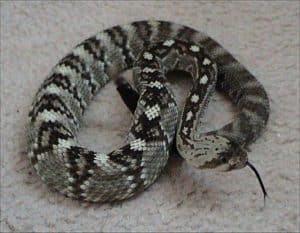
Black Tailed Rattlesnake
The black tailed rattlesnake, scientific name: Crotalus molossus, (not to be mistaken with the black rattlesnake that is also found in the state of Arizona) is found throughout most of Arizona, New Mexico, and part of southwest Texas. There are four recognized sub-species of this particular rattlesnake, but only one of them is found in the United States: the northern black tailed rattlesnake, so that is the only one that we are going to focus on right here.
This is a medium sized rattlesnake, with full grown adults averaging only 30 to 42 inches. Generally the females tend to be larger than the males in this species, and it should be noted that in isolated instances there have been a few records of this sub-species reaching as large as 49 inches in length, but this is definitely a rarity.
Appearance
The appearance of these rattlers can vary greatly. The color range an be yellow and olive green or it can shift all the way to the dark side of the spectrum with various shades of brown or black.
Regardless of the color spectrum, these guys have one consistent appearance marker: their tail scales are completely black. This gives this rattlesnake their unique name, and remains consistent whether they are from the yellow/olive color base or the brown/black color base.
Interesting venom facts
This rattlesnake features a mostly hemotoxic venom, like most of the other species of rattlesnakes in the Crotalid family. That being said, it is very distinctive because it is much less toxic than other snakes in this family. In fact, the venom from a black tailed rattlesnake tends to be only 1/3 as toxic as that found in snakes like the diamondback rattlesnake.
This rattler makes up for it with larger venom glands to inject more venom into a prey or predator to make up for the relative weakness of the venom itself. Bites from these snakes are generally not fatal to healthy humans, but still need to be given proper first aid and treated as soon as possible with the proper antivenom.
Inquisitive yet docile rattler
These rattlesnakes have an unusual dual reputation as they are known to be rather curious and inquisitive, yet they are also considered one of the calmest and most docile of all the rattlesnakes. They are generally very relaxed and rely on their ability to blend in to avoid trouble.
Even when confronted this rattler will normally try to run and get away from a human or any large potential predator, choosing to flee over fight, but like any rattlesnake they will rattle when they feel both cornered and/or threatened and still need to be treated with the same respect as any venomous snake.
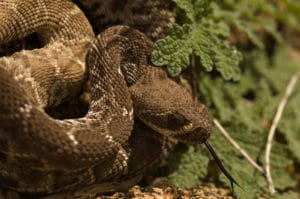
Red Diamond Rattlesnake
If you’ve never heard of a red diamond rattlesnake, don’t feel too bad about it. The chances of actually running into one of these beauties in the United States is next to nothing since well over 90% of the population lives in Baja California, Mexico. The only place they can be found in the United States is southwest California.
The red diamond rattlers (scientific name: Crotalus ruber) are considered a moderately large species, as adults commonly reach 55 inches in length and some even make 60 inches although that is a bit more rare as that definitely counts as a large snake – even for a red diamond rattlesnake! They are reddish brown in color and blend in very well with
There are three subspecies recognized, but only the nominate species is found in the United States, and this species is often also referred to as a “red diamondback rattlesnake” however it is important to note that these are not related to the same species group as the eastern and western diamondback rattlers.
They are distinctively different sub-species despite the similar names.
The red diamond rattlesnake is most commonly found around the cooler coastal zone of southern California, in the local mountains, and even a little bit into the desert. These snakes love country with plenty of brush and cover which is why they love cactus patches, brush covered boulders, and the dense shrubbery that is commonly found in chaparral country in that part of the state.
These are opportunist predators and while they hunt they also gladly wait in ambush for birds, rabbits, lizards, ground squirrels, and even other snakes. When they’re actively hunting it is usually during the dusk, night, or dawn.
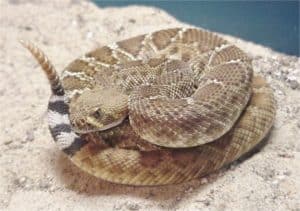
Big docile rattlesnake with heavy venom yield
This large rattlesnake isn’t an aggressive species in temperament at all. They are known for being very mild, but at the same time they will defend their territory and don’t like being backed into a corner or tampered with by people.
The venom itself is considered to be one of the weakest (i.e. least potent) of the rattlesnake venoms out there, however that doesn’t come close to telling the entire story. While the venom itself might be weak by comparison, it comes out in large quantities per bite.
This means that even with the venom being “mild” compared to the toxic impact of other rattlesnake venom, one single bite can deliver three times the amount that is needed to kill a healthy full grown adult. If a bite occurs, fast medical treatment with anti-venom is crucial.
Common symptoms from a bite include: massive tissue swelling (remove any tight clothes, belts, or jewelry immediately), severe pain, hemorrhaging, nausea & vomiting, bleeding, and even outright tissue death (necrosis).
In other words, although the red diamond rattlesnake tends to be docile and prefers to avoid people in areas that don’t see a lot of foot traffic, making bites quite rare, they are very serious and you need to take it seriously if one takes place.
Odd fact: lab studies have showed that this rattlesnake’s venom can be dried and stored and still remains toxic over 20 years later. Incredible.
For more information checkout:

Snake Bite Protection Is Important
Here at Amazing Outdoor Adventures we have not been shy at all about the importance of having the proper protection. Whether a farmer in the Dakotas, rancher down in Texas, or hunter going through classic snake country, you want to make sure that you are as protected as possible.
Whether it’s in the form of a high quality pair of boots that are designed specifically to block the fangs of even the largest North American pit viper, gaiters that will cover the front of your legs to the knees, or if you’re a snake wrangler the right professional quality snake grabber to wrangle them up (and if you need that third one we still strongly recommend good snake proof boots and anti-snake bite gaiters), the right equipment can make all the difference.
While encounter with venomous snakes are relatively rare in the United States as the overwhelming majority of venomous snakes want to avoid people whenever possible, you still want to be properly ready and prepared for the worst case scenario.
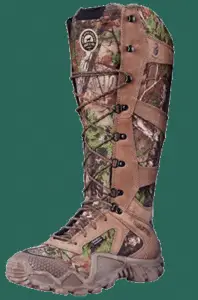
Snake Protection Option #1: Snake Proof Boots
Admittedly I first learned about snake boots due to my paranoia and having to move and work in many wilderness areas where venomous snakes not only lived, but it was all but assumed I would eventually run into one. This particular “fact” did not sit well with me, and I figured I couldn’t be the only one who felt this way.
This was one of those times where the instincts were correct. This is how I originally found out about snake proof boots, and later learned about the snake gaiters that served the same basic purpose while allowing an individual to generally get away with wearing their favorite thick boots as long as the gaiters were properly attached.
However some gaiters wrapped around the leg while others left the back open, which is a questionable design choice considering how many snake bites happen because you step too close without even seeing the snake until it’s too late.
There’s a lot to be said about a good pair of snake boots, and we have already hammered that on another page, so instead of making this even longer by repeating myself we’re going to leave you the link so you can investigate more yourself if you’re interested!
You can check out three of our favorite pairs of snake boots down below for a quick overview of the ones we really like or you can check out a full 4,000+ word review in our complete snake boot guide.
Snake Protection Option #2: Snake Proof Gaiters
While many people with especially large or wide feet have sometimes had trouble finding the perfect fit with a snake proof boot, snake gaiters have provided a high quality protective alternative that wrap around the lower leg, allow you to still wear your favorite hiking or hunting boot, and still give yourself that extra protection where you are most likely to need it most.
These gaiters are among the absolute favorites among individuals who need to work with snakes, who use professional snake tongs to gather snakes for research, or individuals who find themselves working and operating in snake heavy country, having a reliable pair of gaiters that will stop a venomous snake bite cold is extremely important.
These also tend to be a bit more adaptable when it comes to fit, especially for individuals with particularly large or thick calves, which is another reason they are often a favorite of individuals who need to be out in snake country.
They are an important layer of protection and even in most videos where you notice professionals using snake tongs to handle large venomous snakes, all of them are almost always wearing their gaiters.

Snake Protection Option #3: Snake Grabbers
This is one of those products that definitely isn’t going to be for everyone because many of us don’t want to go looking for venomous snakes, much less collecting them. However for those individuals involved in humane animal control or need to collect them for research, you will want to make sure that any snake grabbers that you use are truly top of the line and are going to hold up when you need them to work most.
Professional level reptile grabbers are an important piece of equipment for individuals who need to handle snakes – going with a stick and your hands (even heavily gloved) is just a really, really bad idea. We need to put in the obvious disclaimer here that you should never just go out and start messing with snakes – unless you’re a professional herpetologist or humane pest control.
For most people the answer is to leave them alone, but if you are going to be out and about you definitely want professional level tongs. After all if you are going to go about collecting snakes, you need to make sure you have the right equipment to do it safely!

First Aid for a Venomous Snake Bite
Keeping up with the proper first aid techniques for a venomous snake bite can be difficult. Aside from the many really old “treatments” that have all turned out to be more harmful than good, sometimes there are disagreements on things like constrictor bands or moving a limb.
This means the first aid I learned back in Scouts might be out of date now – keeping on top of the most recent findings is crucial so you know what to do for yourself or for others if you are ever caught in a situation where you are bit by a venomous snake.
Always keep up to date on the newest treatments. They’re not made at random – they’re developed from the most recent medical studies and will give the bite victim the best possible chance of walking away without permanent damage.
So while this is the most updated first aid information on treating a venomous snake bite as of this writing, and we will always work hard to keep this updated, you will want to make sure to keep up on any changes that are made on how treatments should be done.
Treating a Venomous Snake Bite
Step 1: Get the bite victim safely out of range of the angry/aggressive snake. 99% of the time after a bite once you move out of the way the snake will take the first chance it can to get away. The last thing you want is multiple bites and envenomations.
Step 1-A – Try to get a good look at the snake so you can describe it. Different venomous snakes require different antivenom for treatment, so the better the description you can give them, the more effective the medical treatment will be.
Step 2: Help the bite victim get comfortable and talk in a calming voice to encourage them to keep their pulse down. Remove any tight jewelry or clothing. Constriction is not going to be your friend.
Step 3: Clean the wound with water and apply a light bandage. You don’t want this especially tight or constricting, but simply covering to help prevent dirt from entering the wound and causing infection.
Step 4: Keep the snake bite victim as still as possible with the bite below the heart, if possible. Remaining calm and minimizing movement is crucial at this point.
Step 5: Get medical attention as soon as possible. If you can call an ambulance right to your position that’s best, if you’re out in the woods alone you will have to get to a place where you can get picked up, but you still want to take the least amount of effort and movement to get there to minimize the spread of venom.
Step 6: Get transported to the nearest clinic or hospital where you can be treated with the proper antivenom and monitored for side effects, as well as the need for additional dosages or treatment for complications.
Avoid common treatment myths
This is an extremely important part of treating any potentially venomous snake bite. Often times more people in an area believe treatment myths that are more harmful to the bite victim than just leaving the bite alone and doing nothing before getting to medical care. Some of these myths have been disproven for decades yet still cling on stubbornly in the places where snake bites are most likely to occur.
NEVER:
- Never make any lacerations or suck out the poison. You’re only harming the person and possibly yourself – no part of this is good first aid for snake bites!
- Never apply a tourniquet. This will do far more damage than good and when improperly done can be fatal to the person in and of itself.
- Never ignore the snake bite and “walk it off.” Never put off getting medical treatment.
- Never use a snake bite kit. These don’t work and only exacerbate the injury.
- Never apply a cold pack to the afflicted area.
- Never try to capture the snake and risk further injury or aggravation.
Venomous U.S. Snakes FAQ
Q: How important is actual protection from venomous snakes?
A: Generally speaking it is a pretty rare thing to run into venomous snakes but if you are going to be in an area that is their natural habitat while hunting, camping, ranching, or doing other outdoor activities then you should make sure you have the appropriate clothing, tools, and protection.
The most popular include snake proof boots, snake gaiters, and reptile tongs if you absolutely have to move them from an area and can’t leave them alone (which is always the best option).
We are NOT fans of snake bite kits. Read our post “Do Snake Bite Kits Work?” to learn why.
Q: What is the realistic danger from a snake bite?
A: While there are very dangerous venomous snakes in the United States, fast treatment at a proper medical facility with anti-venom has an incredibly high effective rate. There are almost always less than 10 deaths a year compared to over 8,000 venomous snake bites, and many deaths happen to older individuals, people who already have health problems, an allergic reaction, or because the victim didn’t seek medical treatment at all or waited too long to get anti-venom for treatments.
Realistically as long as you seek treatment right away there’s a very good chance you will survive a venomous snake bite, but fast proper treatment does remain extremely important.
Q: So what is the most dangerous venomous snake in the United States?
A: There’s not necessarily a clear answer to this since there are a few ways to measure it. Copperheads are incredibly hard to spot in their habitat and will bite a lot. Coral snakes have the most dangerous venom, but it’s incredibly hard to get bit by one. Diamondback rattlesnakes are generally called the most dangerous because of the toxic nature of their venom, their willingness to strike, and the number of fatal snake bites that tend to come from this species.
If you mean this in the sense of which is most likely to kill or severely harm you in the U.S. then the diamondback rattlesnakes are the ones you really need to watch out for although it is really interesting to note that among rattlesnakes their venom is only third most dangerous, tops, as it is behind Mojave and tiger rattlesnake venom, respectively.
Q: How many species/sub-species of rattlesnakes are there native to the U.S.?
A: It’s hard to get a straight answer on this one. The numbers 14, 15, and 16 come up a lot, which show just how hard it can be to nail down the differences between species and the difference in sub-species numbers is even more with those numbers often hitting over 40, though they are often concentrated a lot more in certain states than others.
Q: How do venomous snakes in the U.S. compare to others in the world?
A: Generally speaking the venom of many of these snakes are quite a bit weaker than snakes you’ll find in Africa, Asia, Australia, or South America. That being said, the biggest reason for the huge disparity between venomous snake bite deaths in the United States and other nations in the world is because of the easy availability of antivenin. Most venomous snake bites are deadly enough to kill someone, so still use caution and if you suffer a bite, take all the necessary steps to get proper treatment ASAP.
Q: Are dry bites from venomous snakes common?
A: Yes, with a major “but.” Snakes prefer to use venom on hunting and can choose whether or not to inject venom when they feel threatened. Among venomous snakes that are found in the United States, estimates show that on average about 1/4th (20-25%) of all bites from pit vipers (copperheads, rattlesnakes, & cottonmouths) are dry in nature while nearly half of all coral snake bites are dry bites.
While this is a high number, medical treatment needs to be undertaken as quickly as possible as most snake bite deaths from otherwise healthy people that take place could have been prevented with fast or immediate care.
Q: What is the best first aid treatment for a venomous snake bite?
A: This is an extremely important bit of information to know. Ideally, you want to immediately move out of the striking range of the venomous snake, note its appearance so you can give that information to medical professionals, and retreat just far enough to sit in a safe spot. Wrap the bite area with a sterile dressing, loosely fit, remove any items that are constrictive in nature (necklaces, belts, tight fighting clothes, etc) keep your heart rate as low as possible with calm breathing, and then immediately drive to the local clinic or hospital for antivenin treatment.
Q: What state has the most venomous snakes?
A: That depends on what you mean by “most.” As far as pure numbers, no one is going to know for sure over so many wild or abandoned acres the exact number of venomous snakes at any given time. When it comes to species, Arizona has the most followed by Texas. These states have the full range of ecosystems that allow thriving populations of snakes. If you mean the four major types (copperheads, water moccasins, rattlesnakes, and coral snakes) then there are multiple states particularly in the South that have all four.
Q: What is the best protection from venomous snake bites?
A: The number one thing is awareness. Understand what snakes are in the area, a little bit about their habitat, and how they are likely camouflaged so you know what to look for. That being said, snakes are designed to really fit in with their surroundings and many are ambush predators. While some will argue between a good pair of snake boots versus snake proof gaiters, both provide a large amount of protection. The gaiters protect higher up the leg, but are often open in the back – some combinations can be used together to give you the full boot and gaiter anti-snake bite combo. Never go cheap – you want quality for these anti-bite pieces of specialty snake clothing.
Q: Is it true that you can be bitten even after the rattlesnake is killed?
A: This might sound like a myth, but it is absolutely true! The heat sensors that rattlesnakes use to locate prey and predators are still active for many hours after death and that means that even after being killed, the biting self-defense reflex remains. Many people have been envenomated after handling the dead snake.
Q: Is it true most venomous snakes are aggressive?
A: No, this is a myth. The far majority of snakes, even very large and venomous ones, simply want to be left alone. That being said, there are major differences in average temperament and potential aggressiveness between the many different species and sub-species of venomous snakes found throughout the United States and even beyond that, individual snakes can have their own temperament based on breeding season, recent interaction with predators, and a wide array of other factors.
Make sure to show all venomous snake respect and give them space they want, but be aware while the snakes hunting down humans for fun is hogwash, there are certain species at certain times that can get extremely aggressive in the right/wrong circumstances.
Q: Which venomous snakes bite the most people?
A: Copperheads actually bite more people than any other specific type of venomous snake. This is easy to understand as they are one of the only snakes that have a defensive strike instinct, and they blend in so well most people never see them before the bite…and some can’t even locate them right away after being bitten.
That being said they’re not deadly in 99.9% of cases if the person is healthy and seeks medical treatment.
Q: Do snake bite kits work?
A: No. The evidence of these having any positive effect is incidental at best, and the venom is already moving in the blood stream. While these kits can be okay for extracting bee stingers, they should not be used on snake bites. If you want our full explanation on this question then check out this full blog post answering why snake bite kits don’t work.
Q: Is it true that anti-venom has severe side effects?
A: Yes. That doesn’t mean you shouldn’t take it. In fact, anti-venom is absolutely crucial to treating a snake bite and helping to save lives as well as make sure that a limb doesn’t suffer severe necrotic damage that can lead to amputation, permanent injury, or even later death. That being said, a strong dose of venom has a really nasty effect on the human body, and although anti-venom will help take care of the worst of it and neutralize those effects, this is still going to be a painful process.
Depending on the type of rattlesnake, how much venom was injected, how quickly treatment could be rendered, and a variety of reaction factors controlled by individual biology. Some people have allergic reactions, while others can handle the rough elements of anti-venom treatment with little issue.
Q: How do I avoid venomous snake bites?
A: The truth is that if you use a lot of common sense, stay aware of your surroundings, and take a couple extra precautions when you know you’re going to be in snake country, you should be fine. The far majority of venomous snakes want nothing to do with you and even ones with a reputation for being aggressive like Cottonmouths, Mojave Rattlesnakes, or diamondback rattlers tend to be defensively aggressive, meaning when they’re cornered, surprised, cut off from their favorite hiding place, or a combination of the three.
By always watching your surroundings, being aware of what to look for, and when in doubt getting some snake boots or snake gaiters in addition to being ultra aware (not in lieu of – these anti snake bite pieces of clothing aren’t a replacement for general awareness) isn’t a bad idea.
Q: If bites are almost never fatal unless I refuse treatment, am allergic, or have a broken immune system, then what’s the big deal?
A: Aside from the fact you should just leave snakes along and let them serve their purpose in the ecosystem, even non-fatal bites can do horrific damage to a person. Aside from many cases of being sick for weeks after the bite (even with anti-venom treatments in some cases) flesh can rot or die, severe damage can be done to muscles, bones, and nerves, and there are cases of amputation or major surgery needing to be done to save the person’s life.
In addition to this even if everything goes 100% smoothly with quick treatment, no complications, and minimal envenomation – you’re dealing with some serious, serious pain and your medical bills are likely starting at $10,000 or more and rising from there. So definitely avoid the snake bite.
Q: What if a threatened or endangered species of rattlesnake encroaches on my property?
A: This is one of those unfortunate things that happens. Generally 99% of the time if you leave the snake alone it will leave you alone, but sometimes a rattler can be looking at a porch or backyard as a breeding place or natural habitat – and for parents with small kids this is often not acceptable, and understandably so.
Generally speaking the best idea, when possible, is to call for pest control that specializes in venomous snake removal and have them take care of it and relocate the snake or snakes. However, if you’re in a situation where a venomous snake is aggressive, the laws do allow in most states for the killing of a potentially dangerous snake when it is in an inhabited area like a backyard or house.
It’s legal to defend yourself against potentially deadly threats when it does come to that, and that supersedes the threatened status.
However, this should be a last resort whenever possible and it only applies to snakes encroaching on inhabited pieces of private property – this does not apply to running into them in the wild or in state or national parks.
Q: Wait I’m confused, what’s the difference between a poisonous snake and a venomous one? Aren’t they the same thing?
A: Here’s a commonly made mistake that drives many people nuts. These snakes are venomous, not poisonous. For something to be poisonous means it poisons you if you eat it. FYI rattlesnake tastes a lot like chicken and doesn’t poison you. 99% of the time snakes aren’t poisonous (this might actually be 100%, I don’t know, I’m not a herpetologist – giving myself that wriggle room in case there is one out there that actually is poisonous to eat).
The PROPER term is venomous. These are venomous snakes because they have the ability to inject you with venom – which acts like poison to your system.
Well I Need a Drink…
I only half kid. Truth is that while I understand the very important role that snakes play in the ecosystem, admittedly that evolutionary fear most of us have is ratcheted up to the point of nearly being a phobia in me. While I wanted to make sure there were good pictures, plenty of resources, and that this long guide would be one of the best online for solid information related to venomous snakes in the States (at least the info you actually want to use or find useful).
This has been a bit rough on me, because the fear of snakes definitely isn’t going away and this article sure didn’t help – as much as I full appreciate how important snakes are to the natural environment and ecosystem. I am, in fact, very pro-conservation when it comes to snakes because of just how important they are to the environment.
Now that being said, my fear of snakes has long been a phobia and at this point it is probably safe to say that this is a fear that isn’t going away any time soon. But let’s face it: preparedness matters and that’s why I went to the trouble of tossing this huge guide together because I wasn’t satisfied with any one stop post or website, and hope this fills the gap for people who were looking for really high quality information on venomous U.S. snakes all in one place like I was.
Let me tell you folks, there was a TON of research that went into this one!
That and hating not finding the exact information I’m looking for after a Google search. Amazing how many searches for a full list of venomous U.S. snakes led to lists of scientific names, a woefully incomplete list, and nothing else. Hopefully ya’ll found this helpful – and kudos to any of you who stayed around to read the entire thing!

